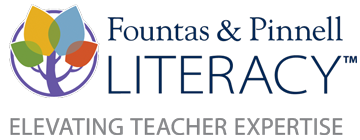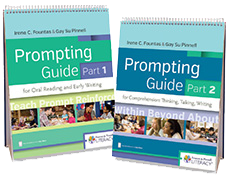Discipline: Professional Resources
Copyright: 2017
Grade(s): K - 8
Delivery Method: Print
Imprint: Heinemann
Author(s): Gay Su Pinnell, Irene C. Fountas

The Fountas & Pinnell Prompting Guides
Fountas & Pinnell Prompting Guides are teacher tools for individuals or groups of students that provide quick and to the point prompts for teachers to instruct students in their area of need.
The Fountas & Pinnell Prompting Guide, Part 2 for Comprehension: Thinking, Talking, Writing
The Fountas & Pinnell Prompting Guide 2, for Comprehension: Thinking, Talking, and Writing contains precise language to use when teaching, prompting for, and reinforcing effective strategic actions in reading and writing. Classroom teachers, reading specialists, literacy teachers, and literacy coaches can use the flip chart as a ready reference while working with students in several instructional setting and contexts.
Fountas and Pinnell provide language for teaching readers how to focus or expand their thinking through talk and writing before, during, and after reading. The goal is to help students think in three broad ways.
- Thinking Within the Text
Noticing and using the information that is directly stated in the text
- Thinking Beyond the Text
Noticing what is implied, not explicitly stated
- Thinking About the Text
Analyzing the writer's craft and thinking critically about the whole text.
The prompts in this flip chart tool are designed to help teachers help teachers demonstrate, prompt for, or reinforce effective reading behaviors related to comprehension including
- Self-monitoring and Self-correcting
- Searching for and Using Meaning
- Summarizing
- Predicting
- Inferring
- Making Connections
- Synthesizing
- Analyzing
- Critiquing

